
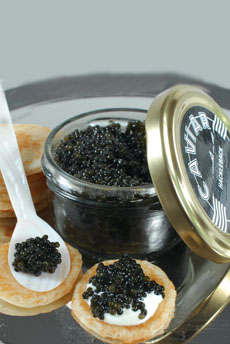 Hackleback caviar is a native product, from a wild sturgeon that lives in the Mississippi and its tributaries. Photo courtesy BackyardGardener.com.
May 2005
Last updated May 2017
|
 |
Caviar Glossary
Page 4: Hackleback & Other Terms With E, F, G & H
This is Page 4 of a ten-page glossary. If you’d like to suggest additional words for inclusion, or think we should consider other definitions than those we have provided, use the Contact Us link on this page. You may also enjoy one of our 60+ other food glossaries.
Click on a letter to get to the appropriate glossary page.
a b c d e f g h i j k l m n o p q r s t u v w x y z
This material is copyrighted and cannot be reproduced in whole or in part
without written permission.
EGGPLANT CAVIAR
A dip or spread made with eggplant, tomatoes, onions, green and red bell peppers and parsley. It contains no caviar. Also called poor man’s caviar.
FARMED CAVIAR
Another term for cultured caviar. See aquaculture and sustainable caviar.
FLAVOR
The taste of most animal food products is highly determined by the environment and what foods those animals eat—the grasses that cattle graze on, the water that oysters grow in, the foods that fish eat. Sturgeon caviar may taste more buttery or more nutty depending on what the fish ate: Sturgeon are omnivores and their diet varies widely by species, location and season. The color also varies based on these situations.
Paddlefish are filter feeders that skim algae and small shrimp (zooplankton) off the water’s surface. Some farmed caviar can acquire a “muddy” or “pondy” taste; whether from diet or culture environment is not clear, and studies are underway to determine this. In general, this flavor comes from farmed fish, not from the wild. Aquaculturists believe that algae in artificial ponds produces an off-flavor in farmed fish.
|
|
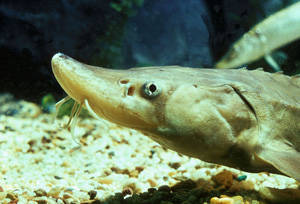
Sturgeon are filter feeders. The flavor of the roe is impacted by what they eat. Photo courtesy Wikimedia Commons. |
Tanks that cycle water slowly, or are in areas that become very hot in the summer, can grow higher levels of algae. Some sturgeon are deliberately farmed in warmer water, to achieve maturity in 8 years rather than in the 12 to 14 year natural cycle; warmer water will produce more algae. Some farms use recirculated water that builds up algae, others use a raceway system that doesn’t. According to one expert we consulted, some farms will purge their fish in clean water for days or weeks without food to try to remove the off-flavor; but the best caviar never introduces it in the first place.
FLAVORED CAVIAR
Sturgeon caviar is naturally black, grey or golden brown in color. It’s also very pricey. But there are excellent options for caviar garnishes. Pale, mild-tasting roe like whitefish and flying fish (tobiko) are flavored and often colored and flavored for extra pizzazz. You can find brown truffled caviar, red beet caviar, green wasabi caviar; yellow citrus, ginger, mango and pepper caviars. Whitefish roe is naturally golden in color; salmon roe is naturally orange. Tobiko is available in orange, green (wasabi) and red. Trout caviar, light orange in color, is also available smoked.
|
|
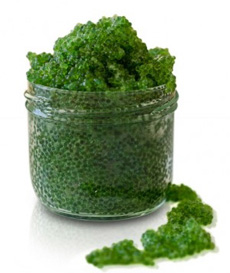
Wasabi-flavore, green-coloredtobiko (flying fish roe). Photo courtesy Pete’s Seafood Club. |
FLYING FISH ROE
See tobiko.
GOLDEN OSETRA CAVIAR
Golden Osetra or Golden Imperial caviar is yellow roe from the most rare, most mature Osetra sturgeons. This type of caviar is highly coveted by connoisseurs, for its firm golden grains that deliver an earthy, nutty and fruity flavor. The color can vary from golden to greenish. Due to its rarity, it is very expensive. See Imperial Caviar.
|
|
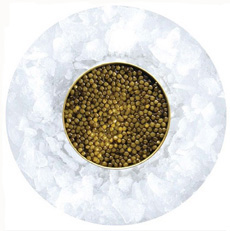
Rare golden Osetra caviar from CaviarCaviar.com. |
It is easy to mistake the rare Golden Osetra caviar, in the photo above, for the extremely rare Almas Caviar, in the photo at right. And, anyone who doesn’t know beans about caviar might be snookered into believing that the vastly affordable Golden Whitefish caviar, below, is the luxurious Almas caviar or Golden Osetra caviar enjoyed by Iranian royalty.
|
|
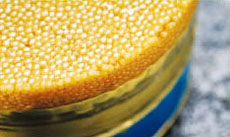
Extremely rare Almas caviar, above, is from an albino osetra sturgeon. It is not the same as Golden Osetra, in the photo above it. |
GOLDEN WHITEFISH CAVIAR or WHITEFISH CAVIAR or AMERICAN GOLDEN CAVIAR or WHITEFISH ROE
An American caviar from whitefish native to the northern Great Lakes (Coregonus clupeaformis from the Salmonidae family). Originally from a European fish species, this is now a hallmark of the American caviar industry. The roe is small, very firm and crisp with great “pop” and a natural golden color. The flavor is less complex than other roe, making them easy to infuse with other flavors.
|
|
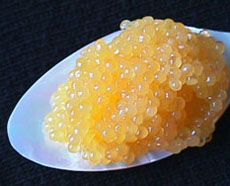
While golden whitefish roe may look similar to the rare Almas caviar above, it tastes nothing like it. Photo courtesy CollinsCaviar.com. |
HACKLEBACK or SHOVELNOSE STURGEON CAVIAR
The fish that produces the most sophisticated wild American sturgeon caviar is the Shovelnose Sturgeon (Scaphirhynchus platorynchus, in the Acipenseridae family*). The shovelnose sturgeon is the smallest freshwater sturgeon native to U.S. It roams wild in the Mississippi and Missouri Rivers and their tributaries; it is found in Tennessee and Illinois. It is the only commercially fished sturgeon in the U.S. Its caviar is marketed as hackleback caviar—a marketing decision as “shovelnose” does not have much appetite appeal. However, there is no “hackleback sturgeon”: hackleback caviar comes from the shovelnose. The caviar has a small, black-to-dark brown bead with a strong-flavored roe. Samples vary by producer and the terroir of the fish. Some hackleback caviar has a sweet, nutty flavor, others can be bland with a short finish.
__________
*The “glamour sturgeon”: beluga, osetra, sevruga, Siberian, trasmontanus, etc., belong to the same family (Acipenseridae) but another genus: Acipenser.
|
|
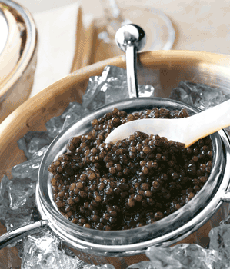
Above: Hackleback sturgeon caviar (photo courtesy Zabars). Below: the shovelnose sturgeon (photo courtesy Ohio River Caviar).
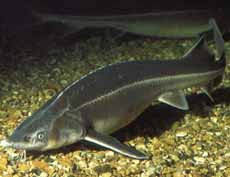
|
Continue To Next Page: Caviar Terms With I To K
Go To The Article Index Above
Lifestyle Direct, Inc. All rights reserved. Images are the copyright of their individual owners.

|